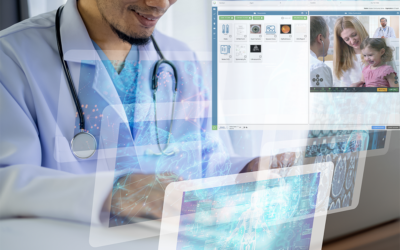Throughout the world, different countries operate vastly different health systems based on need, resources and values. These are especially important to consider in the post-pandemic environment. These systems each have their benefits, but they also come with a range of problems that can limit healthcare access and/or make it more costly for the patient.
We’ll start by breaking down the core components of a well-functioning healthcare system, and then point out how telehealth solutions can improve the delivery of health services.
6 components to consider
The World Health Organization (WHO) defines six components that make up a well-functioning health system. These are:
1. Leadership and governance: Leaders need to be able to anticipate future challenges and have plans in place to meet and overcome them. Telemedicine can give leadership teams expert insights to make smart decisions about future trends.
- Strong, responsive and forward-thinking leadership is the first ingredient to a country’s health system. The leadership team should clearly define policy objectives and devise a plan for achieving them, while at the same time building a regulatory framework to ensure all clinicians and practitioners remain accountable.
2. Health information systems: The right telehealth solutions can ensure that the provider has ready, accurate information on each of their patients, allowing them to better tailor their health plan based on their needs.
- Every decision, plan and procedure undertaken within a health system depends on having good information. Well-functioning health systems need a way of monitoring and assessing how effectively they are collecting, storing, managing and transmitting an individual patient’s electronic medical record.
3. Health financing: Telehealth solutions enable health systems to provide additional billable services, remotely and are now reimbursed for many different engagement modalities (differs by state).
- A health system’s ability to provide quality healthcare is ultimately predicated on whether it has an adequate and secure supply of financial resources. Much of this will depend on the political mood and whether there is sufficient support for public funding of healthcare bodies.

4. Human resources for health: Telemedicine solutions vastly enhance your clinicians’ ability to provide better patient care to a much greater number of people, ultimately improving their productivity levels and staffing resources.
- A health system is only as good as its workforce, so it’s important for governance to establish a good system for recruiting, training and educating the top talent. Once the right workers are on board, health systems need to have comprehensive systems of norms and regulations in place to ensure that every health worker is delivering the utmost level of care.
5. Essential medical products and technologies: Virtual visits via telehealth platforms, became an essential during COVID and is now here to stay. Telemedicine will continue to provide a safe and secure way to treat patients when they need it most, regardless of their physical location.
- Effective health systems must have access to the necessary supplies and equipment to provide the right care to patients whenever they need it. This includes medicines, vaccines and digital health technologies. Health systems need to guarantee safe and secure supply lines, supported and facilitated by legislation and regulation.
6. Service delivery: Telemedicine solutions can play a part here as meeting patients virtually can help the healthcare provider better respond to and monitor individual patients, while also saving them huge amounts of time. This lets them serve more patients, vastly expanding their ability to deliver quality care.
- Health professionals need to have the right networks in place to guarantee that the services they provide can actually be delivered to their patients efficiently and effectively.
Getting started
Telehealth services offer innumerable benefits to those that are ready to transform their operation and begin developing their capabilities. For that, you need a trusted team of experts on your side.
AMD Global Telemedicine is one of the world’s leading pioneers in the telehealth industry, and has been working to develop and deploy these solutions for three decades to over 100 countries. To learn more about AMD, our products or telemedicine technologies, contact us today and find out how we can help improve your telehealth program.
How Can We Help?





